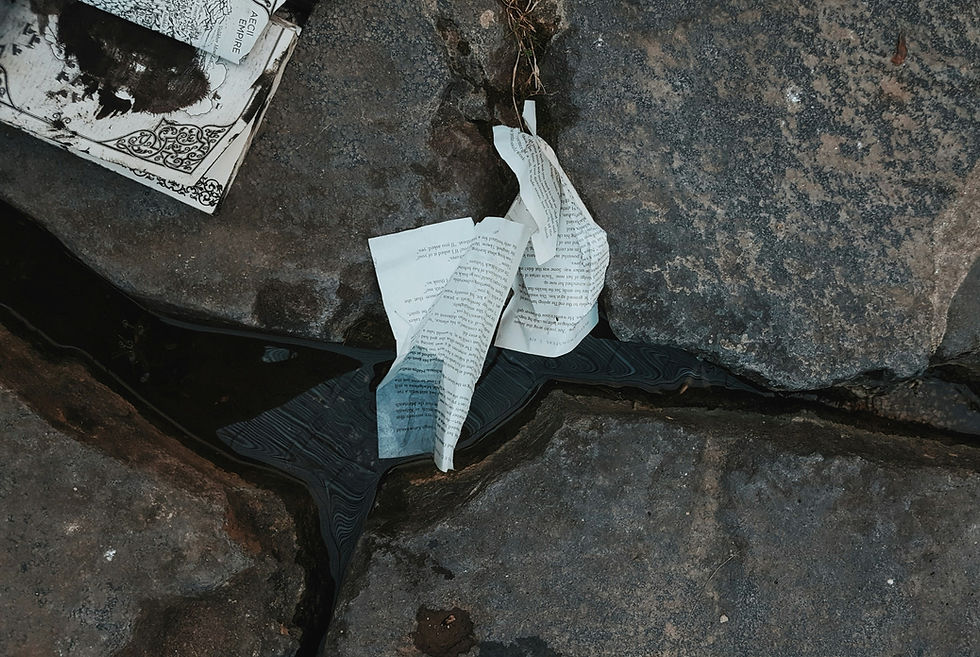Kill Your Darlings: What it Means & How to Do it
- Paige Knight

- Aug 14
- 4 min read

The first time I heard the term “kill your darlings” was on Tumblr. I was a budding writer full of poetry and self-importance, and I saw some angsty black-and-white edit of a scene from the 2013 movie starring Daniel Radcliffe. I watched the movie and, to be honest, I don’t remember anything about it other than that I felt very deep and not like the other girls for watching it.
That was the first time I heard the term, and I didn’t understand what it meant. I took it literally, thinking I’d need to actually kill my favorite characters in order to be considered a good writer. I puzzled over that, wondering whether the rule had some wiggle room. If I loved a character, did that mean they had to die? What about if they’re my narrator? Could a side character do, or would only a main character satiate the Good Writing Gods?
Today, with four years of creative writing workshops and several completed stories under my belt, I’ve realized my mistake. I also realized that I’ve been unintentionally killing darlings for years. Without meaning to, I developed a process for killing darlings gently and (relatively) painlessly. Let’s talk about how I do it.
What Does “Kill Your Darlings” Mean?
There’s a lot of debate about who first coined the phrase, but most people agree that Sir Arthur Quiller-Couch first mentioned the concept in his 1916 book, On the Art of Writing:
“Whenever you feel an impulse to perpetrate a piece of exceptionally fine writing, obey it–wholeheartedly–and delete it before sending your manuscript to press. Murder your darlings.”
Later, William Faulkner paraphrased Quiller-Couch’s sentiments in a letter, telling the recipient to “kill your darlings.” Since then, the phrase has been repeated ad nauseum throughout history, appearing in everything from books on writing and writers’ workshops to online writers’ groups.

Put simply, “kill your darlings” means to edit ruthlessly. It’s common for writers to fall in love with a scene, character, or particular turn of phrase, keeping them in the story even when they no longer belong. In the long run, those beloved scenes and sentences often become our blind spots, hurting the narrative with excessive fluff and frills. The best writers learn to remove anything that doesn’t serve their story (even if it hurts).
My Take on Killing Darlings
In brainstorming for this blog, I found myself wondering what I had to add to this conversation. Do a quick Google search, and you’ll find plenty of other writers who talk about killing darlings. They advise writers to look out for redundancy, to be wary of purple prose, and to combine minor characters who serve similar purposes. Above all, they preach ruthlessness. I felt worried that the bases were already covered.
But then I started to think about my own writing process. I thought about how my stories transform completely as I work through them. Naturally, I tend to write by tearing down and rebuilding, killing darlings along the way without too many tears. Here are some ways that I’ve learned to kill darlings (somewhat) painlessly:
Don’t Kill, Just Lay Gently to Sleep
I'm a big believer in having a drafting process, and I keep everything. Every draft and note gets saved in my files, just in case. Each time I start a new draft, the old one gets saved and tucked away. I still have the original draft of my current WIP–which started as a silly short story riddled with plot holes–seven years later.
Before you ask: yes, this system isn’t always efficient. It’s definitely not tidy. It’s complex and cluttered, but I find it easy to kill darlings because they’re never really dead. My darlings all live on, nestled cozily in my “Previous Drafts” folder. I can visit them anytime I want. That’s what I tell myself, anyways.

Take Your Time
My writing process naturally involves a lot of time. One might say too much time, but we won’t talk about that. My current WIP has been in the works for nearly seven years, and it’s become completely unrecognizable. It started as a short story, cobbled together for a creative writing workshop. I submitted it, received my critiques, and then promptly forgot about it for a year or so.
By the time I returned, I was a different writer. The witty one-liners and charming characters I’d once been in love with were no longer darling to me, and that made it easier to kill them. Today, the only thing that remains from that first draft is the title.
I’m not encouraging you to follow in my footsteps. In a lot of ways, my writing process is inefficient, frustrating, and slow. But it also has the unintended effect of helping me to be more objective about my own work. So, the next time you’re feeling particularly distressed about killing a darling, consider taking some time off. Read others’ work, pick up a new hobby, or work on your other projects. When you come back, you’ll likely feel a bit less attached and a lot more rejuvenated.

Seek Outside Help
I won’t take it quite as far as Quiller-Couch. I won’t tell you to delete all of your favorite sentences, to gut your best scenes, or to remove your most loved characters just because they’re there. However, I will tell you to pay close attention to the pieces of your story that you feel most attached to. Look closely, and consider whether they actually belong.
When all else fails, when you can’t see the forest through the trees, when you can’t figure out what does or doesn’t serve your plot, don’t be afraid to ask for help. Let your closest friends and family read your manuscript, outsource to a beta reader, or consider working with a professional editor. Outsiders will be able to see where a darling doesn’t fit, where plot points are unclear, and where characters lack depth. I can’t promise it won’t hurt, but your work will be better for it.

コメント